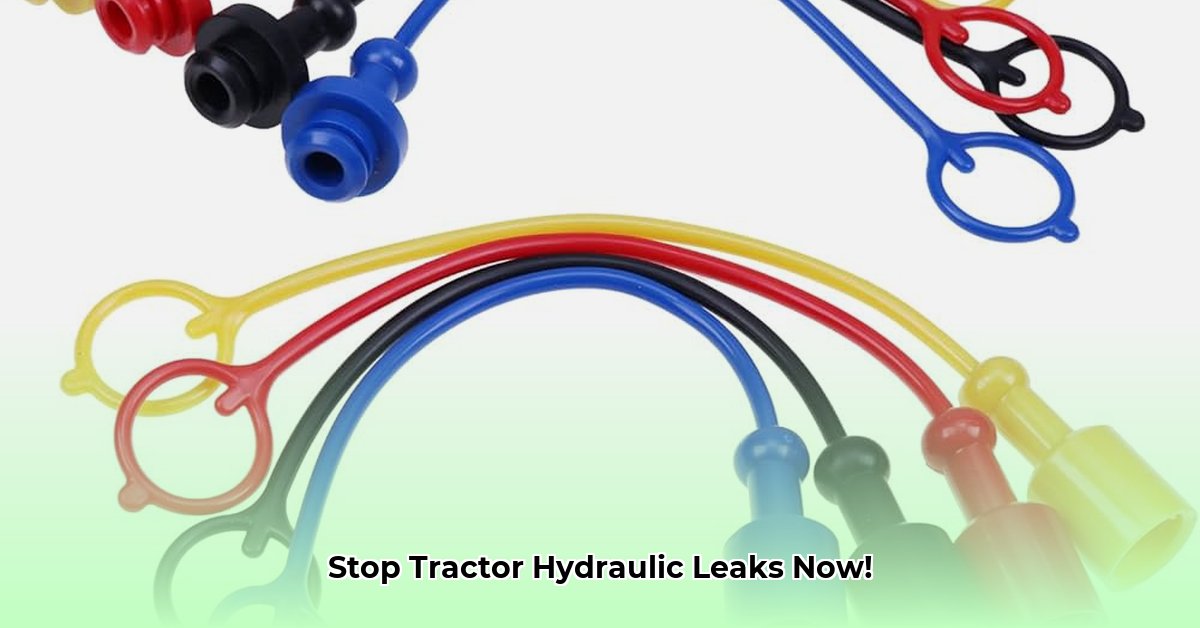
Tractor Hydraulic Dust Caps: Your Guide to Leak Prevention and Extended System Life
Your tractor's hydraulic system is its lifeblood. Maintaining its health ensures smooth operation and prevents costly repairs. A seemingly insignificant component, the hydraulic dust cap, plays a surprisingly crucial role in this process. These small parts protect the system from contamination, preventing leaks and extending the lifespan of your expensive equipment. This guide provides a comprehensive understanding of dust cap selection, installation, and maintenance. For more on tractor hydraulic systems, see this helpful resource on tractor hydraulic pumps.
Why Tractor Hydraulic Dust Caps Matter: Small Parts, Big Impact
Hydraulic dust caps act as the first line of defense against environmental contaminants like dirt, dust, and moisture. These contaminants can damage hydraulic components, leading to leaks, increased wear and tear, and ultimately, expensive repairs. A small investment in proper dust cap maintenance can save you significantly more in repair costs down the line. Isn't preventative maintenance always a better investment than reactive repairs?
Leaks, specifically, create vulnerabilities within the hydraulic system. Even a tiny leak reduces hydraulic pressure, impacting the tractor’s performance. Ignoring a compromised dust cap can potentially lead to complete system failure, causing significant downtime and repair bills.
Types of Tractor Hydraulic Dust Caps: Finding the Right Fit
Several factors influence the type of dust cap needed:
Material: Common materials include rubber (offering good general protection) and polyurethane (providing superior resistance to chemicals and harsh environments). The choice depends on the specific application and environmental conditions.
Size: Accurate measurement of the hydraulic fitting's diameter is critical. Use calipers for precise measurement to ensure a snug fit. Improper sizing leads to leaks and compromised protection.
Application: Operating pressure dictates the cap's pressure resistance. High-pressure systems require caps specifically designed to withstand the force. Overlooking this aspect can be catastrophic.
This table helps you choose the correct dust cap:
| Factor | Consideration | Example |
|---|---|---|
| Hose/Fitting Diameter | Measure precisely (using calipers for accuracy). | 1/2 inch, 3/4 inch, etc. |
| Operating Pressure | Check your tractor's manual for system pressure specifications. | 2000 PSI, 3000 PSI, etc. |
| Environmental Conditions | Consider exposure to extreme temperatures, chemicals, or moisture. | Rubber for sheltered environments; polyurethane for harsher conditions. |
Installing Tractor Hydraulic Dust Caps: A Step-by-Step Guide
Proper installation is crucial to prevent leaks. Follow these steps:
Clean the Port: Thoroughly clean the hydraulic fitting with a clean cloth and suitable solvent to remove any dirt or debris. This ensures a proper seal.
Inspect the Cap: Ensure the dust cap is undamaged and the size is correct. Look for any tears, cracks, or deformities before installation.
Secure the Cap: Firmly push the cap onto the fitting until it snaps into place, or screw it on tightly if it's a threaded cap. A slight 'click' often indicates a secure fit.
Final Check: Visually inspect the connection for any leaks. A small amount of fluid might initially seep, but it should stop once the cap is fully seated. If leakage persists, re-check the installation and size.
Maintenance and Replacement: Preventing Problems Before They Start
Regular inspection is essential to prevent costly repairs. Look for:
Cracks or tears: These indicate wear and tear, requiring immediate replacement.
Swelling or deformation: This suggests material degradation and compromised sealing.
Loosening or displacement: Even minimal movement can lead to gaps and eventual leaks.
Fluid leakage: This requires immediate attention and replacement of the affected dust cap.
Replace any damaged caps promptly. Proactive maintenance is far more cost-effective than emergency repairs. How much does a few minutes of inspection save you compared to a major hydraulic system failure?
Troubleshooting: Tackling Common Issues
Even with careful attention, problems can emerge:
Persistent Leaks: If a new cap still leaks, the fitting itself may be damaged, necessitating professional evaluation and possible replacement.
Installation Difficulties: Ensure the fitting is spotless. For difficult installations, a thin layer of compatible lubricant (like silicone grease) can help. Double-check you are using the correct-sized dust cap.
Safety Precautions: Prioritizing Safety Measures
Always prioritize safety. Before any maintenance, ensure the tractor's hydraulic system is completely turned off. Consult your tractor's manual for specific safety procedures. If you are unsure about any repair or replacement, consult a qualified mechanic.
Conclusion: The Importance of Dust Cap Maintenance
Regular inspection, proper installation, and timely replacement of hydraulic dust caps are critical for preserving the health and longevity of your tractor's hydraulic system. These seemingly minor components offer significant preventative maintenance advantages, protecting your investment and ensuring years of reliable performance. Neglecting dust cap maintenance is an invitation for costly problems. Don't underestimate their importance. They are small but mighty guardians of your tractor's hydraulic system.